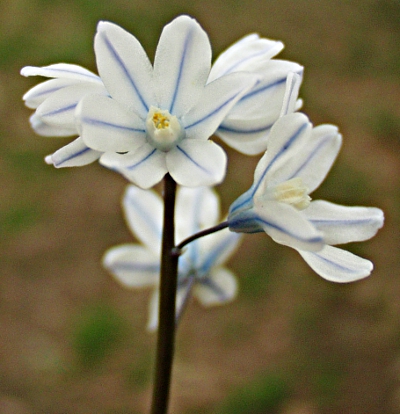Striped squill |


Inflorescence and buds of the striped squill
| Puschkinia scilloides var. libanotica (Zuccarini) Boissier: | |
| Blooming period: | Mach–May |
| Height: | 8–20 cm |
| Flowers: | bisexual, actinomorphic, light blue, conspicuous, Ø 15–20 mm, stamens: 6, styles: 1 |
| Tepals: | 6, pale blue with light blue center stripe |
| Leaves: | mostly 2, basal, parallel-veined |
Plant perennial, herbaceous with an up to 2 cm thick bulb with gray scales.
Stalks upright, incl. flower scape 8–20 cm high.
Leaves 2, basal, 7–24 mm wide, as long as the stalk.
The stalks bears a terminal flower scape with 4–20 slightly nodding, usually unilateral arranged flowers. Pedicels up to 6 mm long, at the base with a very short bract.
The up to 20 mm wide, hermaphrodite flowers are funnel-shaped. The 6 tepals are fused tubular to bell-shaped at the base to a quarter or third of their length. The pale blue petals have a dark blue center stripe.
At the top of the corolla tube arise 6 bent inward stamens with yellow anthers, whose stamens are widened and cover the ovary (corolla appendage).
After insect pollination (bees, bumblebees, wasps) from the superior ovary are formed 3-piece, many-seeded, rounded capsule fruits.
The seeds have a nutrient-rich appendage (elaiosome) and are spread by ants. Propagation also by formation of daughter bulbs. The plant is poisonous in all parts.
In addition to the variety Puschkinia scilloides var. libanotica described here, there exist Puschkinia scilloides var. scilloides whose petals are fused to about half.
| Floral formula: |
| * [P(3+3) A3+3] G(3) superior |
Occurrence:
Roadsides,
parks, public gardens, often near human settlements. Prefers slightly
moist, nutrient-rich soils and warm, semi-shady locations.
Distribution:
Originally
mountain plant of Middle East and Central Asia. In Central Europe
cultivated and escaped from gardens.